The dual-beam welding method is proposed, mainly to solve the adaptability of laser welding to assembly accuracy, improve the stability of the welding process, and improve the quality of the weld, especially for thin plate welding and aluminum alloy welding. Double-beam laser welding can use optical methods to separate the same laser into two separate beams of light for welding. It can also use two different types of lasers to combine, CO2 laser, Nd:YAG laser and high-power semiconductor laser. can be combined. By changing the beam energy, beam spacing, and even the energy distribution pattern of the two beams, the welding temperature field can be adjusted conveniently and flexibly, changing the existence pattern of the holes and the flow pattern of the liquid metal in the molten pool, providing a better solution for the welding process. The vast space of choice is unmatched by single-beam laser welding. It not only has the advantages of large laser welding penetration, fast speed and high precision, but also has great adaptability to materials and joints that are difficult to weld with conventional laser welding.
Principle of double-beam laser welding
Double-beam welding means using two laser beams at the same time during the welding process. The beam arrangement, beam spacing, angle between the two beams, focusing position and the energy ratio of the two beams are all relevant settings in double-beam laser welding. parameter. Normally, during the welding process, there are generally two ways to arrange the double beams. As shown in the figure, one is arranged in series along the welding direction. This arrangement can reduce the cooling rate of the molten pool. Reduces the hardenability tendency of the weld and the generation of pores. The other is to arrange them side by side or crosswise on both sides of the weld to improve the adaptability to the weld gap.
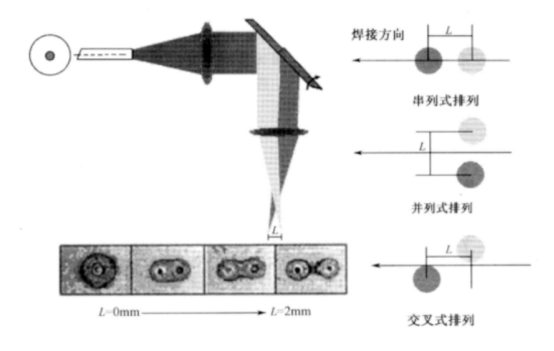

Double beam laser welding principle
Double-beam welding means using two laser beams at the same time during the welding process. The beam arrangement, beam spacing, angle between the two beams, focusing position and the energy ratio of the two beams are all relevant settings in double-beam laser welding. parameter. Normally, during the welding process, there are generally two ways to arrange the double beams. As shown in the figure, one is arranged in series along the welding direction. This arrangement can reduce the cooling rate of the molten pool. Reduces the hardenability tendency of the weld and the generation of pores. The other is to arrange them side by side or crosswise on both sides of the weld to improve the adaptability to the weld gap.
For a tandem-arranged dual-beam laser welding system, there are three different welding mechanisms depending on the distance between the front and rear beams, as shown in the figure below.
1. In the first type of welding mechanism, the distance between the two beams of light is relatively large. One beam of light has a greater energy density and is focused on the surface of the workpiece to produce keyholes in the welding; the other beam of light has a smaller energy density. Only used as a heat source for pre-weld or post-weld heat treatment. Using this welding mechanism, the cooling rate of the welding pool can be controlled within a certain range, which is beneficial to welding some materials with high crack sensitivity, such as high carbon steel, alloy steel, etc., and can also improve the toughness of the weld.
2. In the second type of welding mechanism, the focus distance between the two light beams is relatively small. The two beams of light produce two independent keyholes in a welding pool, which changes the flow pattern of the liquid metal and helps to prevent seizure. It can eliminate the occurrence of defects such as edges and weld bead bulges and improve the weld formation.
3. In the third type of welding mechanism, the distance between the two beams of light is very small. At this time, the two beams of light produce the same keyhole in the welding pool. Compared with single-beam laser welding, because the keyhole size becomes larger and is not easy to close, the welding process is more stable and the gas is easier to discharge, which is beneficial to reducing pores and spatter, and obtaining continuous, uniform and beautiful welds.
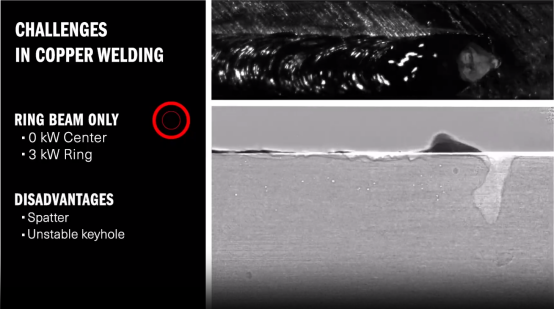
During the welding process, the two laser beams can also be made at a certain angle to each other. The welding mechanism is similar to the parallel double beam welding mechanism. Test results show that by using two high-power OOs with an angle of 30° to each other and a distance of 1~2mm, the laser beam can obtain a funnel-shaped keyhole. The keyhole size is larger and more stable, which can effectively improve the welding quality. In practical applications, the mutual combination of the two beams of light can be changed according to different welding conditions to achieve different welding processes.

6. Implementation method of double-beam laser welding
The acquisition of double beams can be obtained by combining two different laser beams, or one laser beam can be divided into two laser beams for welding using an optical spectrometry system. To split a beam of light into two parallel laser beams of different powers, a spectroscope or some special optical system can be used. The picture shows two schematic diagrams of light splitting principles using focusing mirrors as beam splitters.
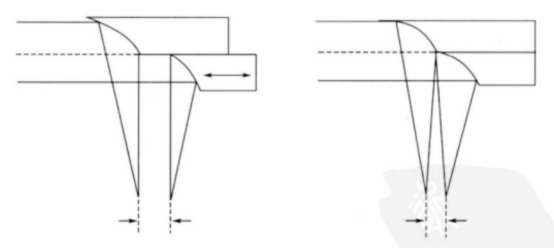
In addition, a reflector can also be used as a beam splitter, and the last reflector in the optical path can be used as a beam splitter. This type of reflector is also called a roof-type reflector. Its reflective surface is not a flat surface, but consists of two planes. The intersection line of the two reflective surfaces is located in the middle of the mirror surface, similar to a roof ridge, as shown in the figure. A beam of parallel light shines on the spectroscope, is reflected by two planes at different angles to form two beams of light, and shines on different positions of the focusing mirror. After focusing, two beams of light are obtained at a certain distance on the surface of the workpiece. By changing the angle between the two reflecting surfaces and the position of the roof, split light beams with different focus distances and arrangements can be obtained.
When using two different types of laser beams to form a double beam, there are many combinations. A high-quality CO2 laser with a Gaussian energy distribution can be used for the main welding work, and a semiconductor laser with a rectangular energy distribution can be used to assist in the heat treatment work. On the one hand, this combination is more economical. On the other hand, the power of the two light beams can be adjusted independently. For different joint forms, an adjustable temperature field can be obtained by adjusting the overlapping position of the laser and the semiconductor laser, which is very suitable for welding. Process control. In addition, YAG laser and CO2 laser can also be combined into a double beam for welding, continuous laser and pulse laser can be combined for welding, and focused beam and defocused beam can also be combined for welding.
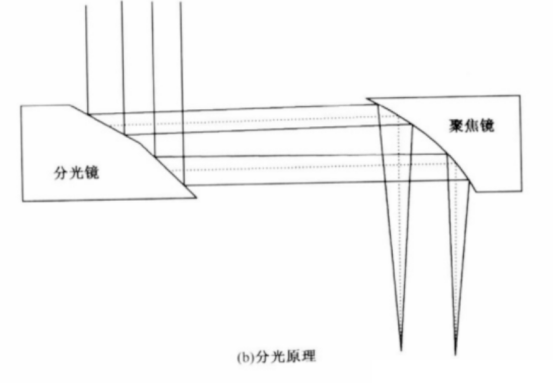
7. Principle of double-beam laser welding
3.1 Double-beam laser welding of galvanized sheets
Galvanized steel sheet is the most commonly used material in the automotive industry. The melting point of steel is around 1500°C, while the boiling point of zinc is only 906°C. Therefore, when using the fusion welding method, a large amount of zinc vapor is usually generated, causing the welding process to be unstable. , forming pores in the weld. For lap joints, the volatilization of the galvanized layer not only occurs on the upper and lower surfaces, but also occurs at the joint surface. During the welding process, zinc vapor quickly ejects out of the molten pool surface in some areas, while in other areas it is difficult for zinc vapor to escape from the molten pool. On the surface of the pool, the welding quality is very unstable.
Double-beam laser welding can solve the welding quality problems caused by zinc vapor. One method is to control the existence time and cooling rate of the molten pool by reasonably matching the energy of the two beams to facilitate the escape of zinc vapor; the other method is Release zinc vapor by pre-punching or grooving. As shown in Figure 6-31, CO2 laser is used for welding. The YAG laser is in front of the CO2 laser and is used to drill holes or cut grooves. The pre-processed holes or grooves provide an escape path for zinc vapor generated during subsequent welding, preventing it from remaining in the molten pool and forming defects.
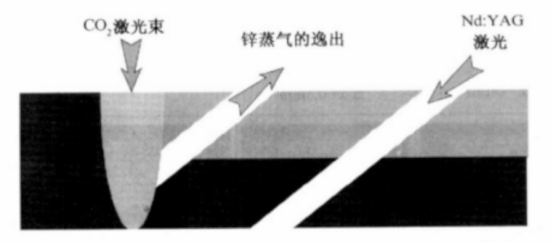
3.2 Double-beam laser welding of aluminum alloy
Due to the special performance characteristics of aluminum alloy materials, there are the following difficulties in using laser welding [39]: aluminum alloy has a low absorption rate of laser, and the initial reflectivity of the CO2 laser beam surface exceeds 90%; aluminum alloy laser welding seams are easy to produce Porosity, cracks; burning of alloy elements during welding, etc. When using single laser welding, it is difficult to establish the keyhole and maintain stability. Double-beam laser welding can increase the size of the keyhole, making it difficult for the keyhole to close, which is beneficial to gas discharge. It can also reduce the cooling rate and reduce the occurrence of pores and welding cracks. Since the welding process is more stable and the amount of spatter is reduced, the weld surface shape obtained by double-beam welding of aluminum alloys is also significantly better than that of single-beam welding. Figure 6-32 shows the appearance of the weld seam of 3mm thick aluminum alloy butt welding using CO2 single-beam laser and double-beam laser welding.
Research shows that when welding 2mm thick 5000 series aluminum alloy, when the distance between the two beams is 0.6~1.0mm, the welding process is relatively stable and the keyhole opening formed is larger, which is conducive to the evaporation and escape of magnesium during the welding process. If the distance between the two beams is too small, the welding process of a single beam will not be stable. If the distance is too large, the welding penetration will be affected, as shown in Figure 6-33. In addition, the energy ratio of the two beams also has a great impact on the welding quality. When the two beams with a spacing of 0.9mm are arranged in series for welding, the energy of the previous beam should be appropriately increased so that the energy ratio of the two beams before and after is greater than 1 :1. It is helpful to improve the quality of welding seam, increase the melting area, and still obtain smooth and beautiful welding seam when the welding speed is high.

3.3 Double beam welding of unequal thickness plates
In industrial production, it is often necessary to weld two or more metal plates of different thicknesses and shapes to form a spliced plate. Especially in automobile production, the application of tailor-welded blanks is becoming more and more widespread. By welding plates with different specifications, surface coatings or properties, the strength can be increased, consumables reduced, and quality reduced. Laser welding of plates of different thicknesses is usually used in panel welding. A major problem is that the plates to be welded must be preformed with high-precision edges and ensure high-precision assembly. The use of double-beam welding of unequal thickness plates can adapt to different changes in plate gaps, butt joints, relative thicknesses and plate materials. It can weld plates with larger edge and gap tolerances and improve welding speed and weld quality.
The main process parameters of Shuangguangdong’s welding of unequal thickness plates can be divided into welding parameters and plate parameters, as shown in the figure. Welding parameters include the power of the two laser beams, welding speed, focus position, welding head angle, beam rotation angle of the double-beam butt joint and welding offset, etc. Board parameters include material size, performance, trimming conditions, board gaps, etc. The power of the two laser beams can be adjusted separately according to different welding purposes. The focus position is generally located on the surface of the thin plate to achieve a stable and efficient welding process. The welding head angle is usually selected to be around 6. If the thickness of the two plates is relatively large, a positive welding head angle can be used, that is, the laser is tilted toward the thin plate, as shown in the picture; when the plate thickness is relatively small, a negative welding head angle can be used. The welding offset is defined as the distance between the laser focus and the edge of the thick plate. By adjusting the welding offset, the amount of weld dent can be reduced and a good weld cross-section can be obtained.
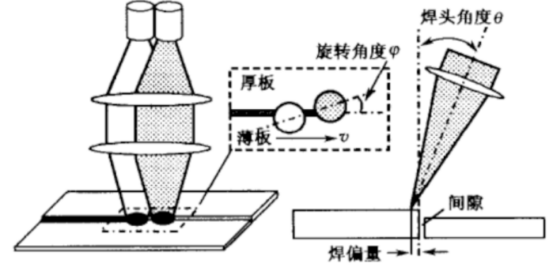
When welding plates with large gaps, you can increase the effective beam heating diameter by rotating the double beam angle to obtain good gap filling capabilities. The width of the top of the weld is determined by the effective beam diameter of the two laser beams, that is, the rotation angle of the beam. The greater the rotation angle, the wider the heating range of the double beam, and the greater the width of the upper part of the weld. The two laser beams play different roles in the welding process. One is mainly used to penetrate the seam, while the other is mainly used to melt the thick plate material to fill the gap. As shown in Figure 6-35, under a positive beam rotation angle (the front beam acts on the thick plate, the rear beam acts on the weld), the front beam is incident on the thick plate to heat and melt the material, and the following one The laser beam creates penetration. The first laser beam in the front can only partially melt the thick plate, but it contributes greatly to the welding process, because it not only melts the side of the thick plate for better gap filling, but also pre-joins the joint material so that the following beams It is easier to weld through joints, allowing for faster welding. In double-beam welding with a negative rotation angle (the front beam acts on the weld, and the rear beam acts on the thick plate), the two beams have exactly the opposite effect. The former beam melts the joint, and the latter beam melts the thick plate to fill it. gap. In this case, the front beam is required to weld through the cold plate, and the welding speed is slower than using a positive beam rotation angle. And due to the preheating effect of the previous beam, the latter beam will melt more thick plate material under the same power. In this case, the power of the latter laser beam should be appropriately reduced. In comparison, using a positive beam rotation angle can appropriately increase the welding speed, and using a negative beam rotation angle can achieve better gap filling. Figure 6-36 shows the influence of different beam rotation angles on the cross-section of the weld.
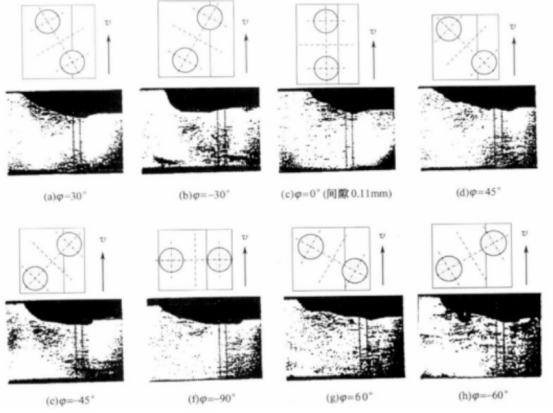
3.4 Double-beam laser welding of large thick plates With the improvement of laser power level and beam quality, laser welding of large thick plates has become a reality. However, because high-power lasers are expensive and welding of large thick plates generally requires filler metal, there are certain limitations in actual production. The use of dual-beam laser welding technology can not only increase the laser power, but also increase the effective beam heating diameter, increase the ability to melt filler wire, stabilize the laser keyhole, improve welding stability, and improve welding quality.
Post time: Apr-29-2024
















